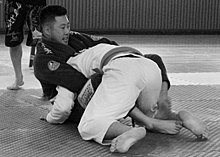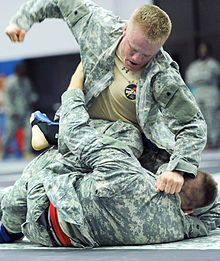Half Guard
The half guard , also known as half mount , is a grappling position in which one fighter lies on top of the other. Depending on the situation, either the upper fighter blocks one leg of the lower one by clinging to it with both legs (top half guard) or the fighter lying on the ground blocks the leg of the upper one (bottom half guard). A half guard can therefore be carried out from above as well as from below. Sometimes one speaks of a half mount when the upper fighter controls.
In wrestling the Half Mount Turk Ride is called. The half guard is an intermediate position between full guard and side control (below) or full mount and side control (above).
Further steps such as sweeps , transitions or submissions can be initiated from the half guard .
Variations
Lockdown
The lockdown (In Judo also known as as niju garami ) is a variant of the half guard, in which the attacker alongside the legs further blocked feet. This allows him to exert even more pressure and mislead the opponent. This creates an even greater chance for a sweep or a submission.
Z-Guard
The Z guard - also known as the 93 guard is a position in which the fighter clamps the opponent's inner thighs with his knees. This position is closely related to the so-called "knee shield". However, this is primarily about keeping the opponent at a distance.
Knee Shield
The Knee Shield blocks the opponent and at the same time allows the greatest possible freedom of movement. This technique is used when the opponent is applying pressure. The disadvantage is that the opponent cannot move away from behind. This is prevented by holding your wrists or sleeves (when fighting GI ).
Deep Half Guard
The Deep Half Guard is a special variant in which the opponent's leg is levered over the shoulder. This position is particularly suitable for short people whose goal is to dive under the enemy and attack his back .
See also
- Grappling
- Mount
- Backmount (martial arts)
- Guard (martial arts)
- Grab handle (martial arts)
- North-South position (martial arts)
Web links
- The Five Commandments of the Underhook Half Guard
- Tutorials of BJJ techniques from half guard
- Half Guard Evolution - Short Article by Stephan Kesting
- Kesting, Stephan. The X guard position . www.grapplearts.com . URL last accessed March 7, 2006.
- Løvstad, Jakob. The mixed martial arts primer . www.idi.ntnu.no . URL last accessed March 6, 2006. (DOC format)
- Page, Nicky. Groundfighting 101 . homepage.ntlworld.com . URL last accessed March 4, 2006.
Individual evidence
- ↑ Masafumi Matsumoto: Why Do Kosen Judo Players Insist on Guard Pulling? In: BJJEE.com. Retrieved March 19, 2017 (English).

